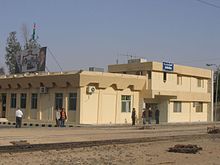Aqaba Railway
| Aqaba Railway | |||||||||||||||||||||||||||||||||||||||||
|---|---|---|---|---|---|---|---|---|---|---|---|---|---|---|---|---|---|---|---|---|---|---|---|---|---|---|---|---|---|---|---|---|---|---|---|---|---|---|---|---|---|
|
Phosphate train at Wadi Rum
| |||||||||||||||||||||||||||||||||||||||||
| Route length: | 116.8 km | ||||||||||||||||||||||||||||||||||||||||
| Gauge : | 1050 mm | ||||||||||||||||||||||||||||||||||||||||
|
|||||||||||||||||||||||||||||||||||||||||
The Aqaba Railway is a railway line that was built to complement the Hejaz Railway network in Jordan . It is used to transport phosphate from the phosphate mines of Abiad and Wadi el Hassa to the port of Aqaba . The term is also used for the operating company, the Phosphat Railway Cooperation , which operates both this new line and part of the Hejaz Railway.
meaning
A branch line of the Hejaz Railway was to be realized as part of the construction of the main line at the beginning of the 20th century. But that failed because of the veto of Great Britain , which classified it as an economic competitor to the Suez Canal and, above all, as a military threat to the Canal. In order to prevent construction, the British Mediterranean fleet was even brought up in front of the Dardanelles and Istanbul in a military threatening gesture in May 1906 . Another attempt was made during the Second World War with the Ma'an – Aqaba railway project , construction of which began but was never completed. The Aqaba Railway was not put into operation until seventy years after the first attempt to build it.
Establishment

After fundamental investigations into a suitable system for this transport service, Jordan decided on a rail connection that
- uses the section of the main line of the Hejaz Railway between the stations Faraifa and Batn al-Ghul and
- from Batn al-Ghul to Aqaba required a new line.
In 1965 a German engineering office, with the help of the Deutsche Bundesbahn , submitted an expert opinion on route variants. The Batn al-Ghul – Aqaba branch line was built on this basis from 1972, and the main line of the Hejaz Railway was renovated in the section used. The phosphate mines were given sidings .
The Faraifa – Batn al-Ghul section is still owned by the Hejaz Railway, an inalienable religious foundation ( Waqf ), and is leased to operate by the Phosphat Railway Cooperation .
The project was financed with a long-term loan from the Kreditanstalt für Wiederaufbau to Jordan as part of German development aid for 232.7 million DM .
On October 6, 1975, the then Jordanian Crown Prince Hassan ibn Talal opened the railway.
business
The traffic is operated by the Phosphat Railway Cooperation with about 800 men.
The entire route is secured by light signals . The mileage is from Aqaba al-Hijaziyya (Hattiyya) and counts towards Aqaba, while the historical mileage is used on the rest of the traveled section of the Hejaz Railway.
Today, three to six pairs of trains run daily on the route in double traction with a length of up to 32 cars. Special trips with cold steam locomotives pushed by a diesel locomotive are carried out for tourists on the route between Aqaba and Wadi Rum .
Locomotives
Type U17, 7 pieces, year of construction 1974
Type U18, 3 pieces, year of construction 1977
Type U20, 12 pieces, built in 1980
Type C24, 4 pieces, year of construction 2007
Freight wagons
Bar-Metro type, curb weight 21 t, payload 42 t, built in 1974
Type Gregg, curb weight 20 t, payload 42 t, built in 1979
Type Samsung, curb weight 18 t, payload 42 to 47 t, built in 1986
literature
- Dieter Noll (Ed.): The Hejaz Railway. A German Railway in the Desert , Werl 1995, ISBN 3-921700-68-X
- Exploration during a study trip of the DGEG in February 2007.
- Neil Robinson: World Rail Atlas and historical summary . Volume 8: The Middle East and Caucasus, 2006.
- Dirk Höllerhage: Aqaba-Bahn - A German Railway in the Desert , Eisenbahn-Kurier, Issue 1/2011, pages 72 to 76
- Matthias Hille: Jordan and the Aqababahn , Fern-Express, issue 3/2015, pages 14 to 19
Web links
- Les Pitcher. Jordan 2012 Aqaba [YouTube video].
- Les Pitcher. Jordan 2012 (2) [YouTube video].
- Les Pitcher. Jordan 2012 (3) [YouTube video].
- Les Pitcher. Jordan 2012 (4) [YouTube video].






